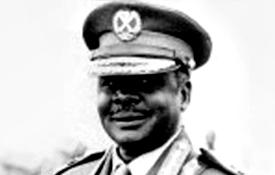Godfrey Lukongwa Binaisa was the fourth President of Uganda. In many circles, he has been called the accidental President given the way he ascended to power. Godfrey Binaisa was born in 1920 to Canon Ananias Binaisa. His father was a well known preacher. He went to King’s College, Buddo one of the leading schools at the time in the country.
Binaisa then qualified as a Lawyer in London in 1955. He became a member of the bar at Lincoln’s Inn in 1956. On his return to the country, he joined politics at a time when the country was variously fighting for independence. He subsequently joined Uganda National Congress (UNC) and later Uganda People’s Congress (UPC).
After Independence, he was named Uganda’s first Attorney General in 1962. He remained in Milton Obote`s ‘good books’ and as one of his ‘right hand men’ through most of the post-independence period. In 1967, he helped create the 1967 Constitution, which among other amendments abolished kingdoms in the country and declared Uganda a republic.
However, shortly after his role in creating this constitution, he left government work and started a law firm in 1969. He stayed in his law firm; one of the most exotic at the time until 1972, a year after Milton Obote’s government was overthrown by Idi Amin.
In 1972, Binaisa claimed that his life was under threat from elements of Idi Amin, prompting him to free to exile. Binaisa worked as a lawyer in London and US between 1972 and 79. It is while there that he rose to the level of ‘Queen’s counsel’. However, even when he was away, he was quietly involved and following the anti-Amin struggle in the country.
When Amin was overthrown, he returned to Uganda and took part in various meetings as part of the post-Amin era. It was through these meetings that he was spotted as a possible ‘figure head’ and hence named to the top office and officially became President of Uganda in June 1979.
His sojourn as the leader of this country came at a time when Uganda was going through a very turbulent time. The capital city, Kampala was awash with all kinds of artillery. Murders, looting and robberies were the order of the day. Many people especially in the central region were not happy that he had replaced their ‘favorite’ Yusuf Lule as President.
In addition, there was also internal acrimony against his presidency. In a bid to try and assert his own control, he deployed the powerful Major General David Oyite Ojok to Algeria as ambassador. He also tried to introduce his own system of governance which he called the ‘Umbrella’ (Minvuli) under which those standing for political office would do so without necessarily belonging to any political party. He lost the Presidency in May 1980 after 11 months as President.
Soon, he ‘sneaked’ out of the country through Kenya and back to the US where he went back to practicing law. In the late 80s, shortly after the NRM government came to power, he was rumored to have started an armed group to fight against the new regime.
He returned to Uganda in 1999 and settled back at home. Occasionally, he would make public appearances at functions. Among other things, he also taught primary school children in Kyengera, near his residence. In 2004, he remarried 56 year old Yamamoto, at the City Town Clerk’s office and even publicly declared that he had regained ‘his youth’. The marriage did not however work out.
In later years, he was in and out of hospital suffering from various illnesses. He died in 2010, aged 91 years old.







